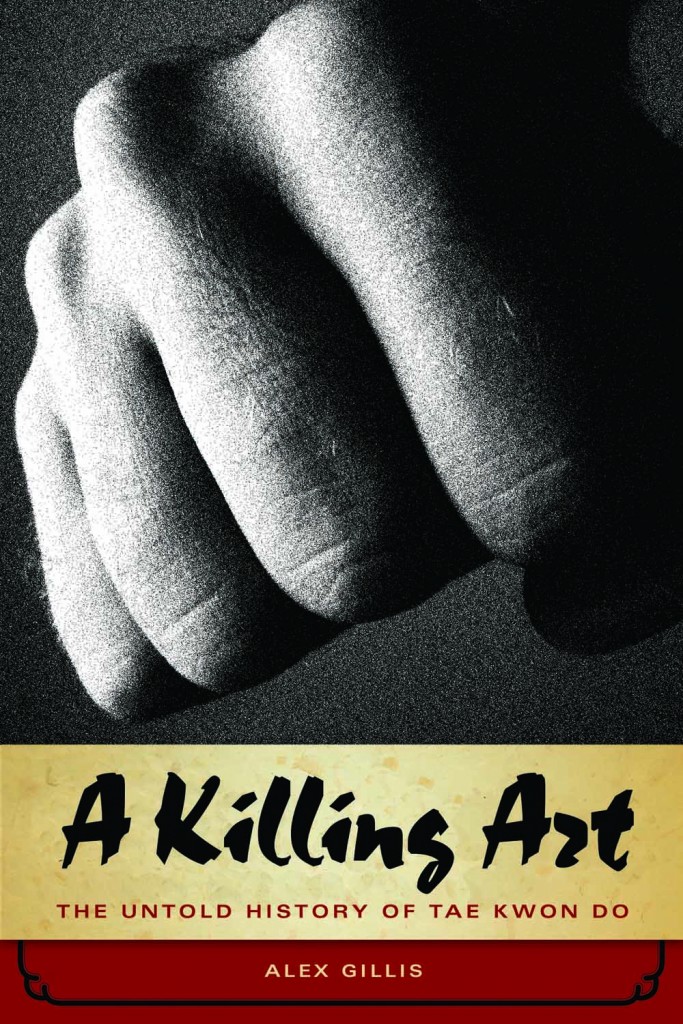Espionage, Congressional scandal, Karate and Korean mobsters – what more does a good book need?
Going over some research on Japan and South Korea I found a review that I originally published in May of 2011. It’s a pretty wild true history and I think it’s worth taking another look at.
“A Killing Art” by Alex Gillis
Reviewed by John Titus
I am sometimes late to the party, but when I get there I drink my share.
Which is why I am thrilled to review “A Killing Art”, by Alex Gillis. This book, which was written in 2008 somehow escaped me until one of my Tae Kwon Do instructors from the past sent me a copy.
And boy did I drink my share; this book is not your typical background of Tae Kwon Do as a contemporary martial art. It is a historical account of The struggle of oppressed Korea, both North and South.
It is the story of the men who fought hand-to-hand in trench warfare against Communist soldiers and returned to refine the Shotokan Karate learned under Japanese rule to a uniquely Korean art that would aid the development of the emerging South Korean industrial tiger. The book is part history, part espionage, and the gradual emerging of western thought in a country that was steeped in stoic Confucian values of the past.
Author Gillis has poured over 4,000 pages of the U.S. Congressional investigation known as “Koreagate”, conducted countless interviews and footnoted every reference in the book for further review. This book was researched in the best of journalistic methods and may be the most comprehensive book on the subject.
“A Killing Art” centers on the struggle between rivals to create Tae Kwon Do from the trench warfare era to present time. General Choi Hong-hi was instrumental in molding Korea’s martial art from Japanese Shotokan, through the phase where nine separate schools (Tang Soo Do, Chung Do Kwan, Ji Do Kwan etc.), all of which had Japanese or Chinese influence became “Tae Kwon Do”, or “foot-fist way”.
General Choi, hardened by the war, favored a realistic fighting system and created the International Tae Kwon Do Association (ITF). Choi’s art retained killing techniques, but began to be out shadowed by the emerging sport version favored by Korean Secret Service official Kim Un-yong. Here begins the internal war between the original battlefield martial art and Olympic sport Tae Kwon Do under the World Tae Kwon Do association (WTF).
Under treaties between the U.S. and South Korea, money for development flowed into South Korea in the 1960’s, and Korea sent 300,000 trained soldiers to aid the U.S. and South Vietnamese in the Vietnam war. Likewise, thousands of U.S. servicemen were trained in using Tae Kwon Do in hand-to-hand combat. Tae Kwon Do became intrinsically linked to war and espionage, with thugs and gangsters enjoying it’s use also.
Author Gillis describes how scandals developed involving the Korean CIA, shakedowns and kidnappings in Europe, The U.S. and elsewhere that led to misery and torture under the hands of Korean dictatorships. Gillis himself interviewed some of these agents in researching the book. Here-in-lies the dark side of the martial art known as Tae Kwon Do.
Alex Gillis pulls no punches in describing how Tae Kwon Do fell into decline with Olympic Tae Kwon Do and the shopping mall McDojo era. He describes the scandals revolving around the Olympics, and how the sport was corrupt and too boring for spectators to follow. The martial spirit was replaced with a careful game of tag that was often predetermined by corrupt judging and what is referred to as “branch trimming”.
What sticks out most clearly, is that the same issues and criticism of Tae Kwon Do as a sport were played out by a bitter, aging General Choi (who appears to have been a North Korean agent) against his rival, the KCIA-embedded Kim Un-yong.
In “A Killing Art”, Alex Gillis has compiled the best history of war-torn Korea and the subsequent dictatorships, the scandals involving espionage, U.S. Congressional members, and the pure athleticism of the men of Tae Kwon Do.
-It’s one of my favorites, and has informed me towards future projects of my own.



This one remains one of my all-time favorites. I think it should be mandatory reading for all styles of TKD. It dispels at lot of the BS that both the WTF and ITF preach.
Good stuff!